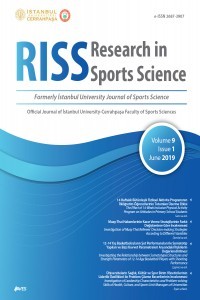Güreşçilere Uygulanan Koenzim Q10 ve Çinko Takviyesinin Bazı Eser Elementler ve Yağ Asitleri Üzerine Olan Etkinin İncelenmesi
Güreş, Koenzim Q 10, Çinko, Eser elementler, yağ asitleri
Investigation of the impact on the some trace elements anf fatty acids of Koenzim Q10 and Zinc Supplements applied to wrestlers
Wrestling, Co-enzym Q 10, Zinc, TraceElements, fattyacids,
___
- Açak M. (2001). Güreş Öğreniyorum, Kubbealtı Yayıncılık, Malatya.
- Balercia G, Arnaldi G, Fazioli F, Serresi M, Alleva R, Mancini A et al (2002) Coenzyme Q10 levels in idiopathic and varicocele-associated asthenozoespermia, Andrologia, 34, 107-111.
- Başaran M. (1989) güreşin öğretim ve antrenman temelleri. Dördüncü baskı, Gençlik ve Spor Akademisi yayınları, Manisa.
- Berg A, John J, Baumstalk M. 1983 Change on HDL subfraction safter a single extended episode of physical exercise .Atherosclerosis; 47:231-40.
- Berk A. , Jhonson T.,Cordeiro, J.A.1983, Lipid and Lipo protein levels in athletes cardiovascular diseases in medicine students 47:231-240.
- Bordin D, Sartorelli L, Bonanni G, Mastrogiacomo I and Scalco E. High intensity physical exercise in duced effects on plasma levels of copper and zinc, Biol Trace Elem Res 1993; 36: 129 – 134.
- Braun B, Clarkson FM, Freedson PS and Kohl RL (1991)
- Effects of coenzymeQ10 supplementation on exercise performance, VO2max, and lipid peroxidation in trained cyclists, Int J Sports Nutr, 1, 353-365. Cordova A andAlvarez-Mon M. Behaviour of zinc in physical exercise: A special reference to immunity and fatigue, Neurosci Biobehave Rev 1995; 19: 439–445.
- Culliane E., Lararus B., Thompson PD. 1981: Acute effecet of a single exercise sesion on serum lipits in untrained msn. ClinChimActa 109:241-244.
- Çolak H, Kale R, Cihan H. Yoğunlaştırılmış yürüyüş ve jogging programının yüksek dansitelli lipo protein (HDL) ve düşük dansiteli lipo proteinler (LDL) üzerine olan etkisi. Ankara Üniversitesi. Beden Eğitimi ve Spor Yüksekokulu Spormetre Beden Eğitimi ve Spor Bilimleri Dergisi, 2003, 1 :69
- Çumralığil B, Nizamlıoğlu M.(2001). Spor ve Beslenme,
- Veteriner Fakültesi Yayın Ünitesi, Konya. Dağ A.ve Baysal A. (1986).Amatör Genç Sporcuların
- Beslenme Alışkanlıkları Üzerine Bir Araştırma. Diabet Yıllığı, Temel Matbaası,202. Delistraty D.A.,Reisman,J.E.,Snipes RD.(1992).A
- Physiological and Nutritional Profile of Young Female Figure Skaters. J Sports MedPhys. Fitness.32,149–55. Eisenmann, J.C.,Wickel, E., Welk, G. J. Ve Blair, S.N. (2005). Relationship between adolescent fitness and fatness and cardiovascular disease risk factors in adulthood: The Aerobics Center Longitudinal Study (ACLS). Am.Heart J., 149,46-53.
- Gasser G A, Robert G.Reffect of hing and lowintensity exercise training on aerobic capacity and blood lipits.Med. SciSport Exerc 1984, 16 : 269-274.
- Guo JY. Evaluation of Exercise-İnduced Muscle Soreness. Un published Doctoral Dissertation, Umeya Universittet, Sweden. Isbn 91–7305-503-4.
- Guyton AC. ( 1986) Textbook of medical physiology.
- WB saunders, philadelphia. Güler D. Gökdemir, K. Ve Günay, M, Türkiye’de Üniversitelerarası Spor Oyunlarına Katılan Futbolcuların Ergojenik Yardımcılar Hakkındaki Bilgileri Ve Kullanma Düzeyleri, Gazi Beden Eğitimi Ve Spor Bilimleri Dergisi, 9 (3), 2004
- Iglesias G.,Pablo M.,García R, Angela G ,Angeles M. (2008).Patterson Food preferences do not influence adolescent high-level athletes’ dietary in take,Appetite, March-May, 536-543.
- Karacan S., Günay M, (1999). The effects of aerobic training program on cardiovascular risk factor. 47-50, 145,2
- Koezuka, N.,Koo, M., Allison, K.R., Adlaf, E.M., Dwyer, J.J.M., Faulkner, G. Ve Goodman, J. (2006).The relationship between sedentary activities and physical inactivity among adolescents: results from the Canadian
- Community Helat Survey.Journal of AdolescentHealt, 39,515-522. Leon A S, Sanchez O A. Response Of blood lipits to exercise training alone or combined with dietary inversention. MEdSci Sport Exerc 2001, 33 (6): 502-515.
- Lichti E, Turner M, Deweese M andHenzel J. Zincconcentration in venous plasma before and after exercise in dogs, MissouriMed 1970; 2: 303–304.
- Loosli A.R.,Benson J.(1986).NutritionHabitsand
- Knowledge In Competitive Adolescent Female Gymnasts. Phys. Sportmed,14,118–124. Mertens D.J.,Kavanagh T., CAmplell R.B., Shephard R.J. 1998, “Exercise without dietary restriction as a means to long-term aft loss in the obese cardiaz patient”, The Journal of Sports Medicine and Physical Fitness, 38 (4):310-316.
- Murray RK. Granner DK. Mayes PA. Rodwel VW. Harper’in Biyokimyası. 24.Baskı. İstanbul: Barış Kitabevi; 19 Nosaka K andClarkson PM. Changes in plasma zinc follow in high force eccentric exercise, Int J Sport Nutr 1992; 2: 175 – 184.
- Parolin ML, Spriet LL, Hultman E, Matsos MP, Effects of PDH activation by dichloroacetate in human skeletal muscle during exercise in hypoxia. Am J PhysiolEndocrinolMetab. 2000; 279: 752-61
- Prentice A, Ginty F, Stear S.J, Jones S.C, Laskey M.A, Cole T.J. (2005). Calcium Supplementation Increases
- Statureand Bone Mineral Mass of 16–18 Year Old Boys. J Clin Endocrinol Metab,90(6),3153–61.
- Steen N.S.andMcKinney S.(1986). Nutrition Assessment of College Wrestlers, Phys.Sports. Med,14,11.
- Tikkanen H O, Hamalainene E, Harkonen M. (2000),Significance of skeletal muscle proproteins on fitness, long-term physical training serum lipits. Atherosclerosis, 142(2): 367:378.
- Tolfrey K.,Campbell IG., Batterham AM. (1998).
- Exercise training in ducealterations in prepubertal children’s lipit-lipo protein profile. MedSci Sports Exerc, 30 : 1684- 16
- Tsugawa N.(2004).Calciumand Vitamin D in takes during infancy, Childhood and Adolescence. Clin Calcium,14,87–94.
- Vallee, B.L. and Falcukh, K.H. : the biochemical basis of zinc physiology, 73, 341 – 363, (1993). 38 İ Ü Spor Bilim Derg
- Başlangıç: 2019
- Yayıncı: İstanbul Üniversitesi-Cerrahpaşa
Güreş Eğitim Merkezlerindeki 12-16 Yaş Sporcuların Motivasyonel Faktörlerinin İncelenmesi
Mehmet Öztürk, Hanife Ataman Yancı, Ayşe Türksoy, Evren Yıldız
6-11 Yaş Grubu İlköğretim Çağı Hareketli ve Hareketsiz Çocuklarda Obezite Prevelansının Belirlenmesi
Yeşer Eskicioğlu, Gazanfer Doğu, Selami Özsoy
Futbolcularda Yaralanma Önleme Programları (Derleme)
Suzan DAL, İlhan ODABAŞ, Nalan SUNA, Çiğdem BULGAN, Selda AKKAYA
